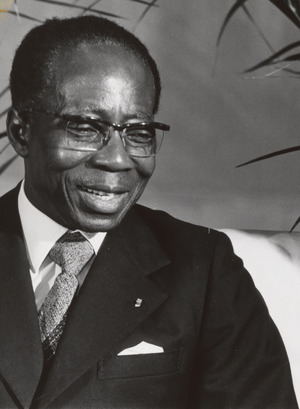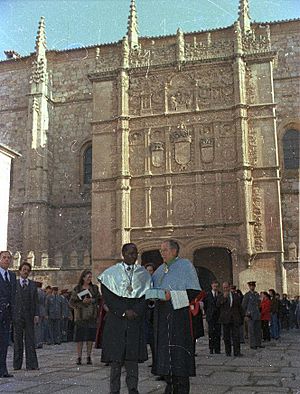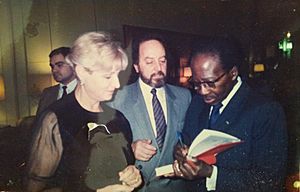Léopold Sédar Senghor facts for kids
Quick facts for kids
Léopold Sédar Senghor
|
|
|---|---|

Senghor in 1978
|
|
| 1st President of Senegal | |
| In office 6 September 1960 – 31 December 1980 |
|
| Prime Minister | Abdou Diouf |
| Preceded by | Office created |
| Succeeded by | Abdou Diouf |
| Personal details | |
| Born | 9 October 1906 Joal, French West Africa (present-day Senegal) |
| Died | 20 December 2001 (aged 95) Verson, France |
| Political party | Socialist Party of Senegal |
| Spouses | Ginette Éboué (1946–1956) Colette Hubert Senghor
(m. 1957–2001) |
| Alma mater | University of Paris |
| Religion | Roman Catholicism |
| Signature |  |
| Military service | |
| Allegiance | |
| Branch/service | French Colonial Army |
| Years of service | 1939–1942 |
| Rank | Private 2e Classe |
| Unit | 59th Colonial Infantry Division |
| Battles/wars | World War II |
Léopold Sédar Senghor (9 October 1906 – 20 December 2001) was a famous Senegalese poet, politician, and thinker. He became the first president of Senegal and led the country from 1960 to 1980.
Senghor was a key figure in developing a philosophy called Négritude. This idea celebrated African culture, black identity, and African strength. He believed that African countries should work closely with France, rather than being completely separate.
He was also the first African person to be chosen as a member of the Académie française, a very important French group that protects the French language. Many people see him as one of the most important African thinkers of the 20th century.
Contents
Early Life and Education (1906–1928)
Léopold Sédar Senghor was born on 9 October 1906 in Joal, a city in Senegal. His father, Basile Diogoye Senghor, was a rich peanut seller from the Serer people. His mother, Gnilane Ndiémé Bakhoum, was his father's third wife.
Senghor's middle name, Sédar, means "one who cannot be shamed" in the Serer language. His last name, Senghor, combines Sène (a Serer family name and the name of their main god) and gor, meaning "man."
When he was eight, Senghor started school at a boarding school in Ngasobil. In 1922, he went to a seminary in Dakar, which is a school for religious studies. Later, he moved to a regular school. He loved French literature and was very good at subjects like French, Latin, Greek, and Algebra. After finishing high school, he won a scholarship to study in France.
Years in France (1928–1944)
In 1928, Senghor moved to France. He studied at the Sorbonne and then at the Lycée Louis-le-Grand. He worked hard to pass a difficult exam called the Agrégation in French Grammar, which would allow him to become a top teacher. He passed it in 1935.
Teaching Career
After graduating, Senghor became a professor at universities in Tours and Paris from 1935 to 1945. He also studied different languages and cultures.
During this time, Senghor and other African thinkers in Paris created the idea of "négritude." This movement aimed to change the negative meaning of the word nègre (a racial slur) into a positive celebration of African culture and identity. It was a way to fight racism and show the world the richness of African traditions. This idea became very important in Senghor's writing and his political views.
Military Service
In 1939, Senghor joined the French army as a private, even though he had a high education. In 1940, during World War II, he was captured by German soldiers. He spent two years in different prison camps. At one point, German soldiers wanted to execute him and other African prisoners, but a French officer stopped them.
While in prison, Senghor wrote many poems and learned German. He was released in 1942 for health reasons. After his release, he continued teaching and also joined the French Resistance, a secret group fighting against the Nazi occupation.
Political Journey (1945–1982)
Working for French Africa
After the war, Senghor became a dean at a French school that trained people for overseas territories. He believed that African countries would be stronger if they stayed connected to France in a federal system. He thought this would give them more rights and resources than being fully independent.
He was elected to the French National Assembly, which is like France's parliament. He supported African workers during a strike, which made him very popular in Senegal. Senghor also pushed for all French territories in Africa to have French citizenship.
Changes in Politics
In 1947, Senghor helped create a new political party in Senegal called the Senegalese Democratic Bloc. This party won the elections in 1951. Senghor continued to be involved in French politics, serving as a state secretary and mayor of Thiès in Senegal. He also helped write France's new constitution.
In 1964, Senghor published the first of his five books called Liberté, which included his speeches and essays.
Leading Senegal
Senghor tried to form a union of West African countries called the Mali Federation with Modibo Keïta, but it did not last long.
On 5 September 1960, Senghor became the first President of the Republic of Senegal. He also wrote Senegal's national anthem. He and his prime minister, Mamadou Dia, had different ideas about how to run the country. In December 1962, Mamadou Dia was arrested and imprisoned for 12 years. After this, Senghor became a very strong leader, and other political parties were not allowed for a time.
On 22 March 1967, someone tried to shoot Senghor, but the gun did not fire. The person was later executed.
Senghor decided to step down from power at the end of 1980, before his term was over. This was unusual for an African leader at the time. Abdou Diouf took over as president. Under Senghor, Senegal later allowed more political parties. Even after colonialism ended, Senegal kept strong ties with France, using French currency and French as the main language for learning.
Supporting French Language and Culture
Senghor strongly supported the creation of La Francophonie, an organization that promotes the French language and culture around the world. He became its vice-president. He also helped start an association to support developing countries.
Later Years and Legacy (1983–2001)
On 2 June 1983, Senghor was elected a member of the Académie française, becoming the first African to join this respected group. His entry was seen as a step towards making the Académie more open.
In 1993, his last book in the Liberté series was published, called Liberté 5: le dialogue des cultures.
Personal Life and Passing
Senghor was married twice. His first wife was Ginette Éboué, and they had two sons. His second wife was Colette Hubert from France, who became Senegal's first First Lady.
Senghor spent his last years in France and passed away on 20 December 2001, at the age of 95. His funeral was held in Dakar, Senegal. Some French leaders did not attend, which caused some discussion about how much France appreciated his contributions.
His Impact
Senghor was a socialist, but he did not follow the anti-Western ideas popular in some parts of Africa after colonialism. He believed in keeping close ties with France and the Western world.
His time as president was marked by the idea of African socialism, which was a unique African way of thinking about society, based on his négritude philosophy. His decision to peacefully hand over power to his successor, Abdou Diouf, helped set a good example for democracy in Senegal.
Senghor's poetry and ideas about politics are still important today. His poetry captures the spirit of the Négritude movement and holds a special place in literary history. He believed that Africans needed to develop their own culture, separate from colonial powers, to truly progress. His work continues to inspire people around the world.
The airport in Dakar was renamed Léopold Sédar Senghor International Airport in 1996, on his 90th birthday. A bridge in Paris was also renamed after him in 2006.
Awards and Recognition
Senghor received many awards and honors throughout his life. He was given the highest honors in France, like the Grand-Croix of the Légion d'honneur. His service in the war also earned him medals. He received honorary doctorates (special degrees) from 37 universities around the world.
In 1971, he received a special medal for the 2500th Anniversary of the founding of the Persian Empire. In 1978, he was made a Knight of the Collar of the Order of Isabella the Catholic in Spain. The Senghor French Language International University in Egypt was named after him in 1990.
Poetry
Senghor's poetry was very well-known. In 1978, he won the Prix mondial Cino Del Duca, a major international literary prize.
In 1948, he put together a collection of French-language poetry by black writers called Anthologie de la nouvelle poésie nègre et malgache. A famous French writer, Jean-Paul Sartre, wrote the introduction for it.
Senghor wrote a poem for his own epitaph, which is a short text written on a tombstone. Here is part of it:
- When I'm dead, my friends, place me below Shadowy Joal,
- On the hill, by the bank of the Mamanguedy, near the ear of Serpents' Sanctuary.
- But place me between the Lion and ancestral Tening-Ndyae.
Négritude Philosophy
Senghor, along with Aimé Césaire and Léon Damas, created the idea of Négritude. This was a very important intellectual movement that aimed to celebrate and value what they believed were unique African qualities, values, and art.
Senghor believed that black people had a special way of reacting to the world that was more direct and connected to feelings. This idea was a response to the strong influence of French culture in the colonies and the mistaken belief that Africa did not have a developed culture.
Senghor argued that Africa and Europe were connected through history, from ancient Egypt to Greece and Rome. He emphasized that négritude was not about being against white people, but about encouraging understanding and exchange between different cultures, like European, African, and Arab cultures.
Works by Senghor
- Chants d'ombre (1945)
- Hosties noires (1948)
- Anthologie de la nouvelle poésie nègre et malgache (1948)
- Éthiopiques (1956)
- Nocturnes (1961)
- Nation et voie africaine du socialisme (1961)
- Poèmes (1964)
- Lettres de d'hivernage (1973)
- Élégies majeures (1979)
- Ce que je crois (1988)
Images for kids
-
Léopold Sédar Senghor with Habib Bourguiba and Mohamed Sayah at Carthage Palace, 1980.
-
A 2006 memorial stamp from Moldova honoring Senghor.
See also
 In Spanish: Léopold Sédar Senghor para niños
In Spanish: Léopold Sédar Senghor para niños
- Serer people
- List of Senegalese writers





